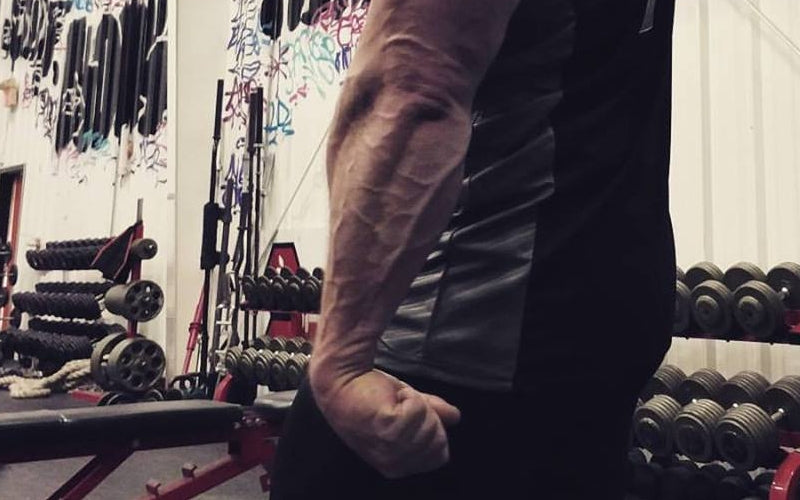
Basic Grip Strength Training for the Deadlifter
Grip issues are kind of a big deal. Most deadlifters either refuse to use lifting straps when pulling over fear that it will hinder grip strength, or they struggle with a weak grip in general.
Hopefully, this article will help you improve both your grip strength and your deadlifts.
Related - Two Types of Grip Strength
First, let me say this. If your grip keeps slipping when deadlifting, you need to both start doing some grip training and wear lifting straps or Versa Gripps.
What?
Yes, you heard me correctly. You need to start wearing straps. Losing your grip during a heavy pull will increase the risk of injury. You don't want your body torquing left or right, and with it your spine and lower back, because of a failing grip.
Not worth the risk.
But how will you build grip strength if you're forced to use lifting straps? Easy enough question to answer; I'm going to give you a good starter program.
Before I dive into the program, let me mention something that just might be a reality. There exists the possibility that grip strength is strongly tied to overall back strength. When your back is weak the brain will signal your grip to give out so you don't hurt yourself. On the other hand, if your grip is strong your brain has no reason for you to let go.
Make sense?
So here's the thing. If you make your back stronger it only increases the likelihood that with it, your grip strength will also increase. One of the best ways to strengthen your back is to wear straps or Versa Gripps so your grip doesn't limit the rate by which you increase back strength.
Basically, don't let the strength of a smaller muscle group limit the strength of a bigger one.
Alright. Even of the lead-in. Let's get to grip training.

Grip Strength Training
Let's start with some basics. To build a better grip, you need to hold stuff stat challenges you. This first workout will focus on two types of "holding stuff":
- Hangs - Secure your hands on a pull-up bar and simply hold yourself as long as possible until your grip, or your will to live gives out.
- Static Holds - Place a barbell in a rack, slightly above or below knee level; whichever feels best for you. Now, lift the barbell from the pins and hold it for as long as possible, or until you lose your will to live.
I recommend running the following workout approach for at least four to six weeks, or until you lose your will to live. You'll be training grip twice a week. It's probably best to perform this work at the end of your regular sessions.
Workout 1 - Foundation Grip Workout
Session A
- Hangs - 2 to 3 sets of maximum time.
Session B
- Static Holds - 2 to 3 sets of maximum time.
When you can reach 30 seconds for all sets of static holds, add 20 pounds to the bar the next time you perform this movement.
That's it. Nothing complicated but it will help you build a better base. Now let's move on to something a bit more challenging.
Workout 2 - Superset Grip Workout
Both sessions are the same. Perform hangs, rest 15 seconds, then move on to static holds. Rest for about a minute and repeat each superset.
Sessions A & B
- Hangs - A set for maximum time.
- Rest 15 seconds.
- Static Holds - A set for maximum time.
Repeat this sequence three times.
When you can reach 30 seconds for all sets of static holds, add 20 pounds to the bar the next time you perform this movement.
Crush Grippers and Wrist Rollers - Moving On
Once this becomes routine and rather dull, I suggest adding crush grippers and wrist rollers to the equation. A crush gripper can be taken anywhere, so no real need to program this exercise. Simply hit it when you feel like it.
For wrist rollers, add three to four sets on to each session. While wrist rollers are not specifically a grip-strengthening exercise, they will help build freaky and strong forearms.
From here you can add in pinch grip training. Pinch grip is simply the act of holding a weight between your thumb and a single, or a multiple number of fingers. This type of grip training will be performed for maximum time.
A suggested way to train pinch grip is to hold two smaller 5 or 10-pound places together with your thumb and finger(s).
Grip Training Recap
For those keeping score at home, here are the official names for each type of grip training:
- Support Grip - Holding something with your hands for as long as possible.
- Crush Grip - Think of a crushing handshake or crushing a can with your mighty grip power.
- Pinch Grip - The ability to "pinch hold" an object or objects with your thumb and a finger or multiple fingers.






